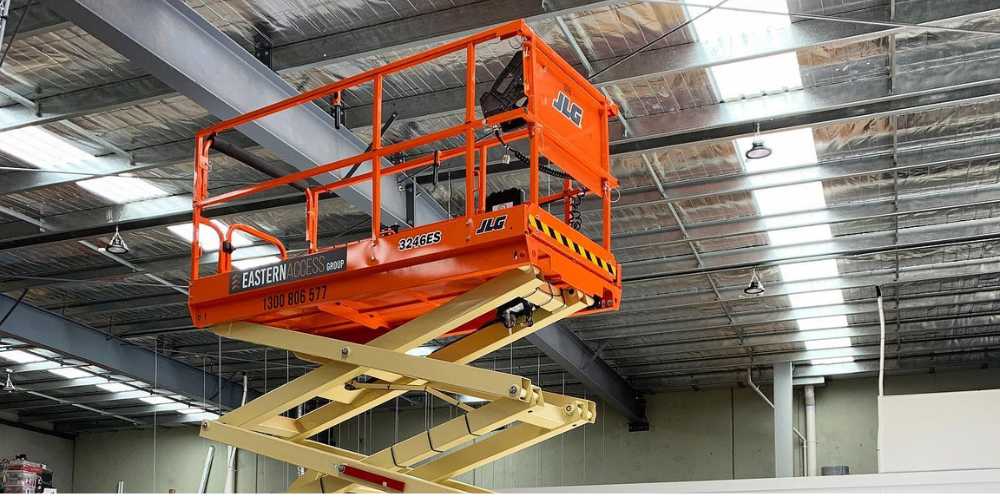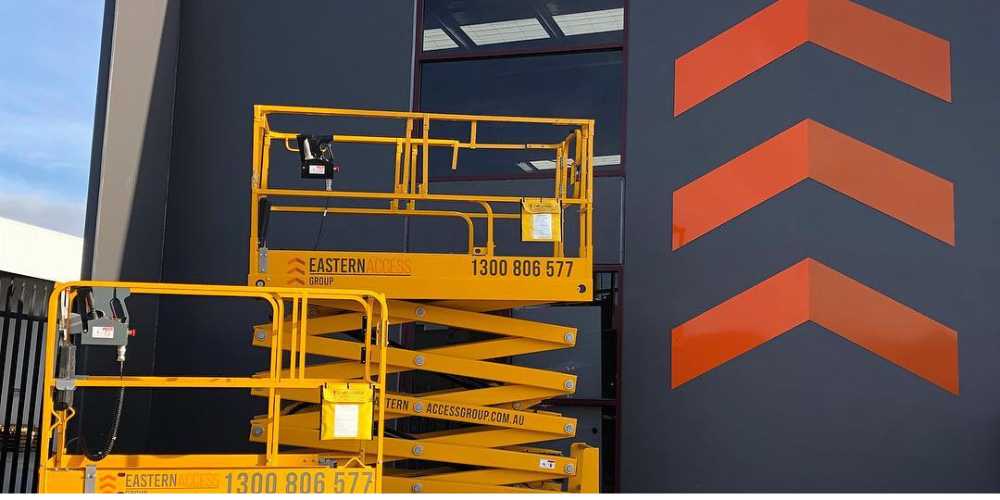Can Scissor Lifts Be Left Outside After Use?
Table of Contents
If you’ve ever used a scissor lift or are thinking about it, you might wonder whether leaving them outside when you’re done is okay. We are here to shed some light on this common question.
Scissor lifts are crucial in various industries, and knowing how to care for them can save you a lot of trouble (and money).
So, whether you’re a seasoned pro or just interested in scissor lifts, this blog is your backstage pass to figuring out when it’s safe to let your scissor lift face the weather and when it might need a nice location indoors. Let us share with you our own maintenance tips on keeping one of the most handy elevated work platform equipment healthy and working.
Let’s get started!
Understanding Scissor Lifts
What is a Scissor Lift?
Let’s start with the basics. Scissor lifts are those incredible equipment at construction sites, warehouses, and even big events. They’re the superheroes of elevation, and they go by many names, but “scissor lift” is the most frequent.
Imagine a large metal table with a crisscross of steel underneath, similar to huge scissors. That is the scissor part. When you want to get up high, you push a button (or pull a lever), and these steel arms extend, carrying you, your tools, or your stuff. They’re like your personal sky elevator but stronger than a ladder.

How Do Scissor Lifts Work?
Scissor lifts operate on a relatively simple yet ingenious principle. A scissor lift’s heart is a group of crossing metal supports that resemble a pair of scissors, thus the name. A hydraulic system or mechanical connection connects these supports.
When pressure is supplied to the hydraulic system, the scissor arms stretch, raising the platform. When the pressure is released, the arms retract, lowering the platform to the appropriate height or returning it to its resting position.
Scissor lifts have an amazing vertical reach, with some models stretching more than 60 feet into the air. Scissor lifts are useful for various operations, including construction, maintenance, and warehousing, because of their exact control over height adjustment and stability.
Components of a Scissor Lift
Understanding a scissor lift’s components is vital for operators and maintenance personnel. Here are some key parts you’ll find in most scissor lift models:
Platform: This is where operators will stand or place things. It is usually equipped with guardrails for safety.
Scissor Mechanism: The crisscrossing supports that extend and retract to raise and lower the platform comprise the lift’s core.
Hydraulic System: Hydraulic cylinders supply the force to operate the scissor arms in hydraulic scissor lifts. To trigger the lift, hydraulic fluid is pressured.
Controls: These can vary, but they usually feature buttons or levers for raising, lowering, and steering the scissor lift.
Base: The lift’s bottom section houses the wheels or stabilizing legs and provides stability during operation.
Power Source: Scissor lifts can run on electricity, gasoline, diesel, or compressed air. Where and how they may be utilized are determined by the power source.
Factors to Consider When Leaving Scissor Lifts Outside
Weather Conditions
You’ve got to respect Mother Nature, especially when leaving your scissor lift outdoors. Here are some weather-related things to keep in mind:
Rain: Scissor lifts dislike becoming wet. Rain may cause corrosion, electrical problems, and slippery surfaces, making them less safe to operate.
Snow and Ice: If you live in a cold climate, snow and ice may cause havoc with your lift. They can cause components to freeze, making operation difficult and potentially damaging.
Excessive Heat: Blazing heat might be an issue. If you’re not careful, it might degrade lift performance and cause overheating.
UV Rays Exposure
While the sun is lovely for picnics, it may be hard on scissor lifts. Plastics and rubber parts can degrade when exposed to UV light for an extended period. So, if you sunbathe every day, you should reconsider.
Theft and Vandalism
Unfortunately, not everyone appreciates your scissor lift as much as you do. Leaving it alone outside might expose it to theft or damage. People prefer to return to their elevator to discover missing components or worse.
Maintenance Requirements
Last, consider the maintenance required to keep your scissor lift in good working order. Outdoor storage may need more frequent cleaning and lubrication to avoid environmental damage.

Potential Consequences of Leaving Scissor Lifts Outdoors
Leaving your scissor lift outdoors in the weather can have several undesirable effects:
Corrosion and Rust
The metal parts of the scissor lift may rust and corrode when stored outside, especially in moist, humid environments. As a result, its structural integrity is compromised over time in addition to how it looks.
Electricity Problems
Rain or snow can leak into electrical parts, causing short circuits and other problems. These problems may affect the lift’s control mechanisms, endangering operators and requiring maintenance downtime.
Safety Issues
Safety issues arise when a scissor lift is improperly maintained due to exposure to the elements. Accidents caused by rust, electrical issues, and weak structural components pose a major risk to operators and neighbouring workers.
Reduced Lifespan
Scissor lifts are expensive, and how well they are cared for will determine how long they last. The lifespan of the lift might be severely shortened by exposure to harsh exterior elements, requiring early replacement or expensive maintenance.
Best Practices for Storing Scissor Lifts
To ensure the longevity and reliable performance of your scissor lift, consider the following best practices for storage:
Internal Storage
Store your scissor lift indoors if feasible. Indoor storage offers the best defence against inclement weather, UV radiation, and the possibility of theft or damage. Rust, electrical problems, and other weather-related damage are far less likely to occur in a dry, controlled environment.
Covered Storage
Choose covered storage options if indoor storage is not an option. A strong, weatherproof structure like a garage, shed, or warehouse may protect your scissor lift from rain, snow, and too much sun. It may not provide the same security as indoor storage, but it is a vast improvement over exposing the elevator completely.
Cleanliness and Maintenance
Maintaining the condition of your scissor lift requires routine maintenance. Establish a regular maintenance program that covers lubricating moving parts, examining electrical parts, and fixing any problems as soon as they arise. Rust, electrical issues, and security risks may all be avoided with proper maintenance.
Use of Protective Covers
Invest in some protective coverings made just for scissor lifts. These coverings protect your equipment from rain, snow, and UV radiation. Covering your scissor lift while not in use adds another line of defence from the elements.
Frequently Asked Questions
Generally speaking, scissor lifts are not intended for usage on public highways and might not comply with the required standards for road safety. A trailer or a vehicle with safe transport capabilities is typically needed to carry a scissor lift from one place to another. Always follow the rules and regulations for local traffic.
Scissor lifts are made for operating at moderate to substantial heights; nonetheless, they are not appropriate for heights that tower cranes or other specialist aerial platforms can reach. The model and type determine the maximum working height of a scissor lift.
To offer stability on flat, level surfaces, scissor lifts are built. On the unlevel ground, using them might be dangerous. Operate stabilizing outriggers, matting, or cribbing to guarantee stability and abide by the manufacturer’s instructions for safe operation if you operate a scissor lift on uneven terrain.
Scissor lifts are available in various sizes, including small variants ideal for confined places. These smaller lifts are appropriate for indoor and limited work locations since they can pass through typical entrances and narrow corridors.
Conclusion
Remember that scissor lifts are wonderful equipment for various sectors, providing a secure means to operate at elevated heights. But just like any equipment, they must be handled with deference and care.
As usual, if you have questions regarding anything connected to scissor lifts, don’t hesitate to check the manufacturer’s instructions local laws, or ask experts in the area for guidance. Your operations should always prioritize efficiency and safety.

